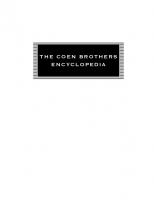The Coen brothers' Fargo 9780511098833, 9780521005012, 9780521808859
128 73 46MB
English Pages [176] Year 2004
Frontmatter
Acknowledgments (page xi)
Contributors (page xiii)
1 Introduction (William Luhr, page 1)
2 Fargo in Context: The Middle of Nowhere? (David Sterritt, page 10)
3 Motherhood, Homicide, and Swedish Meatballs: The Quiet Triumph of the Maternal in Fargo (Pamela Grace, page 33)
4 Fargo, or the Blank Frontier (Christopher Sharrett, page 55)
5 "Kinda Funny Lookin'": Steve Buscemi's Disorderly Body (Mikita Brottman, page 77)
6 Fargo: "Far Removed from the Stereotypes of..." (William Luhr, page 92)
7 Closer to the Life Than the Conventions of Cinema: Interview with the Coen Brothers (conducted in Cannes on May 16, 1996) (Michel Ciment and Hubert Niogret, page 109)
8 Cold-Blooded Scheming: Roger Deakins and Fargo (Chris Probst, page 119)
9 Carter Burwell in Conversation: Music for the Films of Joel and Ethan Coen (Philip Brophy, page 128)
10 Review of Fargo (Thomas Doherty, page 137)
11 Prairie Home Death Trip (Harvey Roy Greenberg, page 142)
Filmography of Joel and Ethan Coen (page 151)
Selected Bibliography (page 157)
Index (page 159)
Recommend Papers

- Author / Uploaded
- William Luhr
File loading please wait...
Citation preview
The Coen Brothers’ Fargo - , Fargo is the most commercially and critically successful film of Ethan and Joel Coen. Immediately recognized as an important work, it was © nominated for five Academy Awards and received two, an exceptional achievement for a low-budget, independently produced film without major stars. Fargo is also a film that explores middle-American themes and settings from an original and unsettling perspective, challenging traditional genre structures. This volume explores Fargo from various
methodological perspectives. Providing a detailed account of the film’s , production, reception, and place within the career of the Coen brothers, it explores issues and themes that are important to current film discourse, including genre, gender and sexuality, race, history, culture, and myth. William Luhr is professor of English at St. Peter’s College, Jersey City, New Jersey. Co-Chair of the Columbia University Seminar on Cinema
and Interdisciplinary Interpretation, he has written, co-authored, and edited many books and articles on aspects of film, most recently Thinking About Movies: Watching, Questioning, Enjoying, Second Edition.
BLANK PAGE
THE CAMBRIDGE UNIVERSITY PRESS FILM HANDBOOKS SERIES
General Editor: Andrew Horton, University of Oklahoma Each CAMBRIDGE FILM HANDBOOK is intended to focus on a single film from various theoretical, critical, and contextual perspectives. This “prism” approach is designed to give students and general readers valu-
able background and insight into the cinematic, artistic, cultural, and sociopolitical importance of individual films by including essays by leading film scholars and critics. Furthermore, these handbooks by their very nature are meant to help the reader better grasp the nature of the critical and theoretical discourse on cinema as an art form, as a visual medium, and as a cultural product. Filmographies and selected bibliographies are added to help the reader go further on his or her own exploration of the film under consideration.
Oklahoma ,
VOLUMES IN THE SERIES
Buster Keaton’s “Sherlock Jr.,” ed. by Andrew Horton, University of | Spike Lee’s “Do the Right Thing,” ed. by Mark Reid, University of Florida Ozu’s “Tokyo Story,” ed. by David Desser, University of Illinois,
_ Urbana-Champaign Francis Ford Coppola’s “The Godfather Trilogy,” ed. by Nick Browne,
University of California, Los Angeles |
Alfred Hitchcock’s “Rear Window,” ed. by John Belton Godard’s “Pierrot le Fou,” ed. by David Wills, Louisiana State University Bufiuel’s “The Discreet Charm of the Bourgeoisie,” ed. by Marsha Kinder,
University of Southern California Ingmar Bergman’s “Persona,” ed. by Lloyd Michaels, Allegheny College Arthur Penn’s “Bonnie and Clyde,” ed. by Lester Friedman, Northwestern University Sam Peckinpah’s “The Wild Bunch,” ed. by Steven Prince, Virginia
Polytechnic and State University _
~ BLANK PAGE
_ Fargo The Coen Brothers|
Edited by
, WILLIAM G. LUHR |
Saint Peter’s College, Jersey City, New Jersey ,
CAMBRIDGE — SS) UNIVERSITY PRESS _
PUBLISHED BY THE PRESS SYNDICATE OF THE UNIVERSITY OF CAMBRIDGE
The Pitt Building, Trumpington Street, Cambridge, United Kingdom CAMBRIDGE UNIVERSITY PRESS
The Edinburgh Building, Cambridge CB2 2RU, UK 40 West 20th Street, New York, NY 10011-4211, USA 477 Williamstown Road, Port Melbourne, VIC 3207, Australia Ruiz de Alarcon 13, 28014 Madrid, Spain Dock House, The Waterfront, Cape Town 8001, South Africa
http://www.cambridge.org © Cambridge University Press 2004
This book is in copyright. Subject to statutory exception and to the provisions of relevant collective licensing agreements, no reproduction of any part may take place without the written permission of Cambridge University Press.
, First published 2004 Printed in the United States of America Typefaces Stone Serif 9.5/13.75 pt. and Gill Sans — System WX 2¢ [TB]
| A catalog record for this book is available from the British Library. Library of Congress Cataloging in Publication Data
The Coen brothers Fargo / edited by William G. Luhr p. cm. -— (Cambridge University Press film handbooks series) Includes bibliographical references and index. ISBN 0-521-80885-5 — ISBN 0-521-00501-9 (pb.)
1. Coen, Ethan 2. Coen, Joel 3. Fargo (Motion picture) I. Luhr, William. II. Cambridge film handbooks series. PN1997.F3456C64 2003
791.43'72 —dc21 2003043847
ISBN O 521 80885 5 hardback ISBN 0 521 00501 9 paperback
For Walter and Richie
BLANK PAGE -
Contents | | Acknowledgments page xi
Contributors Xili 1- Introduction | | 1| William Luhr David Sterritt |
2 Fargo in Context: The Middle of Nowhere? 10 3 Motherhood, Homicide, and Swedish Meatballs: | The Quiet Triumph of the Maternal in Fargo 33
Pamela Grace , 4 Fargo, or the Blank Frontier 55
Body 77 Mikita Brottman | Christopher Sharrett
5 “Kinda Funny Lookin’”: Steve Buscemi’s Disorderly
6 Fargo: “Far Removed from the Stereotypes of...” 972 William Luhr |
; 7 Closer to the Life Than the Conventions of Cinema: Interview with the Coen Brothers (conducted in
Cannes on May 16,1996) _ 109
Michel Ciment and Hubert Niogret
x CONTENTS | 8 Cold-Blooded Scheming: Roger Deakins and Fargo 119 Chris Probst
9 Carter Burwell in Conversation: Music for the Films
of Joel and Ethan Coen 128
Philip Brophy
10 Review of Fargo 137 Thomas Doherty
11 Prairie Home Death Trip 142 Harvey Roy Greenberg
Index 159
Filmography of Joel and Ethan Coen 151
Selected Bibliography 157
Acknowledgments
First thanks go to Krin Gabbard of the State University of New York
at Stony Brook for his generous assistance with this project from the beginning and for his consistently helpful insights. I also want to thank the New York University Faculty Resource Network, along _ with Bill Simon, Robert Sklar, and Chris Straayer of the Department of Cinema Studies, who have been invaluable in providing research help and facilities, as have Charles Silver, Steve Higgins, and the staff
of the Film Study Center of the Museum of Modern Art. Generous | assistance has also come from the members of the Columbia University Seminar on Cinema and Interdisciplinary Interpretation, particularly my co-chair, David Sterritt, as well as Krin Gabbard and Christopher Sharrett, and Robert L. Belknap, Director of the University Seminars. Pamela Grace of the seminar has been tirelessly help-
ful with research and technical assistance. At Saint Peter’s College, | gratitude goes to Academic Vice President Eugene Cornacchia, PhD,
Bill Knapp and the staff of the Instructional Resources Center, the members of the Committee for the Professional Development of the Faculty, Dr. John M. Walsh, Dr. Victoria Sullivan, Dr. Thomas Kenny, Dr. Alessandro Calianese, David X. Stump, S. J., Oscar Magnan, S. J., and Dr. Leonor I. Lega for generous support, technical assistance, and
research help. Mrs. Barbara Pedone has kindly provided extensive assistance in preparing the manuscript. Professor John T. Yurko of Caldwell College has been skillfully and generously helpful with the xi
xii ACKNOWLEDGMENTS
illustrations for this book. As always, I am deeply indebted to my father; Helen and Grace; my brothers, Walter and Richie (to whom this book is dedicated); Bob, Carole, Jim, Randy, Roger, Judy, and David. My brother Richard and my oldest friend, Robert Banka, passed away during the writing of this book, and I want most particularly to re-
member them here.
I also want to express the following formal thanks: | The editor expresses appreciation to the University Seminars at Columbia University for their help in publication. The ideas presented in this volume have benefited from discussions in the Uni- _ versity Seminar on Cinema and Interdisciplinary Interpretation. I am grateful to the following for permission to reprint materials
in this volume: : , Philip Brophy for permission to reprint the interview with Carter Burwell published in Cinesonic — The World of Sound on Film, edited by Philip Brophy, AFTRS Publishing, Sydney 1999
(http://www.aftrs.edu.au/shoponline/).
Michel Ciment and Hubert Niogret of the Editorial Board of Positif for permission to reprint their interview with the Coen brothers
published in the September 1996 issue. , oe Gary Crowdus, Editor-in-Chief of Cineaste Magazine, for permission to reprint Thomas Doherty’s review of Fargo from the Volume 22, No. 2 (1996) issue.
| Harvey Roy Greenberg, MD, for permission to reprint his essay, “Prairie Home Death Trip.” Jim McCullaugh, Executive Director/Publisher of American Cine- _. matographer, for permission to reprint Chris Probst’s article on Roger Deakins from the March 1996 edition. This article is reprinted with the permission of American Cinematographer, 1996, 2002.
- Contributors | MIKITA BROTTMAN gained her PhD from Oxford University in 1994. She is the author of Car Crash Culture (Palgrave, 2001), Offensive Films (Greenwood, 1994), Meat Is Murder (Creation, 1998), Hollywood Hex (Creation, 1999), and an edited collection of essays on the films of Jack
| Nicholson (2000). She has published essays on the horror film and film , theory in numerous journals, including Film Quarterly and Literature/Film
of Art. | |
Quarterly, and serves on the editorial board of Unscene Film. She is cur- , rently Assistant Professor of Literature at the Maryland Institute College , PAMELA GRACE holds a certificate in Psychoanalytic Psychotherapy from Washington Square Institute, an MSW from Columbia University, and is completing her PhD in Cinema Studies at New York University. Her long involvement with feminist issues includes serving as Vice President of the Ms Foundation for Women and functioning as a delegate © to the Fourth World Women’s NGO (Nongovernmental Organization) Conference in Beijing. She has taught film at New York University and Brooklyn College.
WILLIAM LUBR is Professor of English at Saint Peter’s College and CoChair (with David Sterritt) of the Columbia University Seminar on Cinema and Interdisciplinary Interpretation. Among his books as author, coauthor, or editor are Raymond Chandler and Film (Second Edition, Florida State University Press, 1991); World Cinema Since 1945 (Ungar, 1987); The Maltese Falcon: John Huston, Director (Rutgers University Press, 1995); Thinking About Movies: Watching, Questioning, Enjoying (Second Edition,
| | xiii
Xiv CONTRIBUTORS Blackwell, 2003), and Blake Edwards (Volumes I [1981] and II [1989], Ohio University Press). He has contributed to numerous journals and is currently working on a book on film noir.
CHRISTOPHER SHARRETT is Professor of Communication at Seton Hall University. He is editor of Mythologies of Violence in Postmodern Media (1999) and Crisis Cinema: The Apocalyptic Idea in Postmodern Narrative
Film (1993). His work has appeared in Cineaste, Film Quarterly, Journal of Popular Film and Television, CineAction, Persistence of Vision, and elsewhere, including such anthologies as The Dread of Difference: Gender and The Horror Film, The New American Cinema, and Perspectives on German Cinema.
DAVID STERRITT has been Film Critic of The Christian Science Moni-
tor for more than 30 years. He is Professor of Theater and Film at the C. W. Post Campus of Long Island University, a member of the Film Stud-
ies Faculty at Columbia University, and author/editor of several books including The Films of Jean-Luc Godard: Seeing the Invisible (Cambridge University Press, 1999) and Mad to Be Saved: The Beats, the ‘50s, and Film (Southern Illinois University Press, 1998). He has twice served as Chair
of the New York Film Critics Circle and is a former programmer of the
New York Film Festival at Lincoln Center. ,
WILLIAM LUHR , Introduction
Fargo (1996) is Ethan and Joel Coens’ most commercially and critically successful film (Fig. 1). It merits the kinds of examination this
book offers not only on its virtues as a remarkable film, but also as one that provides insights into the Coen brothers’ singular career, and into significant recent trends in both the film industry and American culture. Immediately and widely recognized as an important work, it received two Academy Awards (Best Actress for Frances McDormand and Best Writing, Screenplay Written Directly for the Screen, for Ethan Coen and Joel Coen) and was nominated for five more (Best Cinematography, Best Director, Best Film Editing, Best Picture, and Best Supporting Actor). It also received accolades from such
prestigious venues as the Cannes Film Festival, the British Academy Awards, the Chicago Film Critics Association, and the New York Film Critics Circle. This is highly unusual for a low-budget, independently produced film without major stars. Further, this aspect of the film’s success places it within the trend of the rise of independent filmmaking and distribution in the 1980s and 1990s. During this period, for a cluster of reasons, numerous films made and/or distributed outside the major Hollywood studios enjoyed unprecedented cross-over success into major markets. Fargo is not only important as an independent film of the 1990s that signals major shifts in the film industry,
but it is also a haunting and delightful one that explores middle- | American themes and settings from an original and unsettling I
2 WILLIAM LUHR perspective, that challenges traditional cinematic genre structures,
, and that comments on American racial, gender, and cultural _ traditions.
It does this as a film by the Coen brothers, a writing/directing/ producing team that has displayed unusual assurance, as well as a distinctive vision from their first film, Blood Simple (1984), nearly 20 years ago. The distinctiveness of their vision is evident in the difficulties that many, even among its champions, have had in classifying Fargo. Some have placed it in the tradition of film noir, others call it a comedy, and some call it both.
Fargo is a particularly useful film for the Cambridge Film Handbooks series because the very diversity of its characterizations leads viewers in varied, at times contradictory, and often provocative directions. On some levels, such potentially confusing responses result from little more than jokes. For example, the credited editor, Roderick
| Jaynes (who was nominated for an Academy Award) does not exist; the name is a pseudonym for the Coen brothers, one they have used in other films. Other aspects of the film that produce di- _ verse interpretation are more complex. An opening title asserts that “This is a true story. The events depicted in this film took place in Minnesota in 1987. At the request of the survivors, the names have been changed. Out of respect for the dead, the rest has been told
| exactly as it occurred.” A closing title, however, directly contradicts this and states that “No similarity to actual persons living or dead is intended or should be inferred.” Although these certainly are contra| dictory statements, the first one is also part of a complex strategy to guide the viewer’s response to the film. Regardless of whether the first
statement is true, it is certainly no joke. It sets a somber mood that is reinforced by the tone of the opening scenes. Unlike some Coen films that begin by evoking old film genres or broad comedy, this one establishes the mood of a grim buildup to a “true crime” from the recent past. With ominous music on the soundtrack, an isolated car crawls across a frozen landscape. The driver soon meets with two criminals to set a doomed series of crimes in motion. Fact-based or
PES ae ee ee INTRODUCTION =.
Ye PMR leeaaron te CN an ee a A wot JE i ee | CU Ct ae EP werd 8, VOCUS ne
. OP ee ee SO -
ee a rrrrrr—r—“NsirCNCOCCiC iC iOOCNCsiszt«sC.«.«.||. i wniiaCi(#OiwOiwtCCwCdsésCkst«ss«s«s«ye”r—“irws—rsrw—TdsSstCCiésK=tSSsstCiCtiséa’wCtisizwsrzsSCSw;stsSS—~SiCtw
eel lL ee Cr i a err————™——“BE
; Seee 2 eeltra ee ee ee Saas oe SS cs Ee RSEerr SE ee 0) SRR ee een ORee a cresrrt—si“(#sSCCdCRU rs—SsiSiazsac
errr mrrrhrrr—s—SS eo llr lt twtr a
- Oe —(‘ avmrmrrlrmrmrmrmrmrmrm~S~SU~C llmlmmlmlUMKDlmlmlmlUMUMU
Oo SE le | I Te
NR —e,r,rhr,r——COtit a
a— . £ - 2 eee lUmUmlmrUCrmMmLrermrmlmlmwOwO~O~O”w”O”O”W”WOWOWOWOwOwéwé~é~é“‘“CO“








